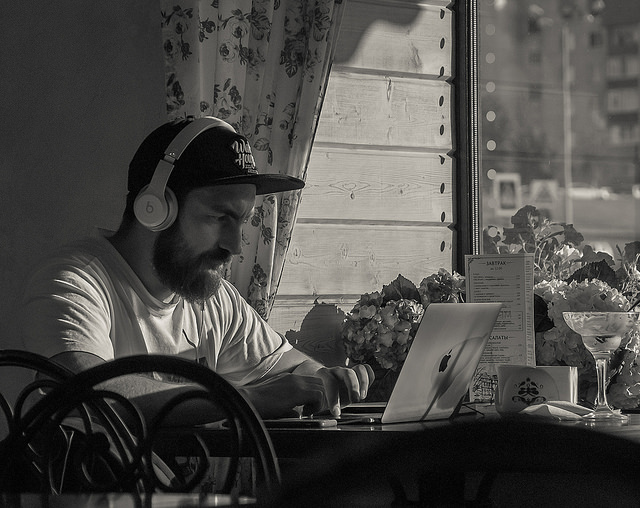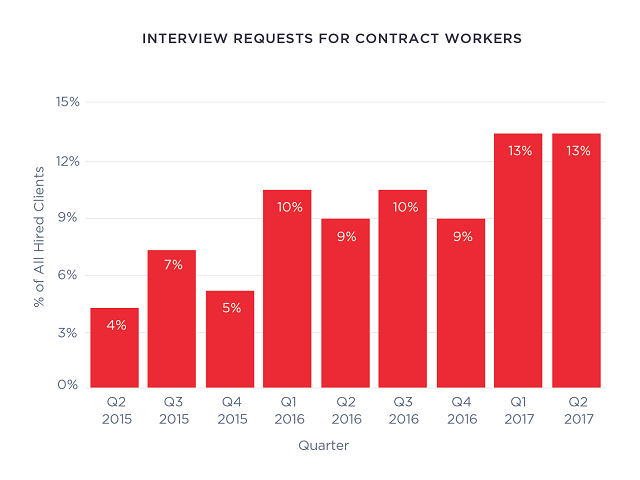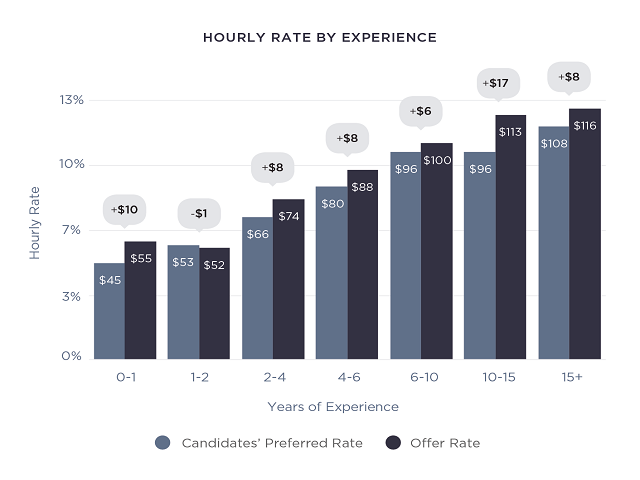 INFRA
INFRA
 INFRA
INFRA
 INFRA
INFRA
For a few years now, a number of reports have documented that more and more people are deciding to go freelance. That may mean forgoing the two-week paid holiday in the Caribbean, but for some workers, especially in the tech milieu, it also means more personal freedom, the chance to work and travel, and the ability to be your own boss.
According to a recent report, it also means you are out-earning people doing a similar job within a company. A 2016 report called “Freelancing in America: 2016” revealed that 35 percent of the U.S. workforce is now freelance, earning in total about $1 trillion in 2016. Much of this work has been made possible because of freelance sites such as UpWork, but it also has never been more convenient with so many communication and collaboration tools.
San Francisco-based recruitment company Hired Inc. has been surveying how the freelance gig economy has been developing, having assessed more than 175,000 interviews from 10,000 companies over the last year. In a detailed report, Hired predicts that we are going to see even more people switching to freelance work in the future. “Data from Hired shows that 20 percent of U.S.-based candidates and 24 percent of Europe-based candidates on the Hired platform are interested in contract work,” the report said. It also said 13 percent of companies were looking for contract workers instead of full-time staff, which was an all-time high.

It also said that those generally looking for contract work had at least six years’ experience, but those with 15 years or more experience were charging around $28 an hour more than the former applicants. What was maybe more surprising is how much more freelancers are earning compared to company employees. “Hired’s data shows that a 1099 freelancer working 40-hour weeks is paid an average of $24,918 more annually than a full-time W-2 employee ($147,680 and $122,762, respectively).”
But it also found that few freelancers work a 40-hour week, while company employees said they often worked more than their 40-hour contract asked of them. The data revealed that if the freelancers interviewed did indeed work 40 hours, the wage disparity would be even more significant. Hired went on to say that “our data also shows that the average contractor on the Hired platform only works 24 hours a week. This is often a lifestyle decision by the contractor.”

It’s not completely a walk down easy street, though. Hired pointed out the downside of no company benefits, no company insurance and perhaps a lack of retirement savings might be an issue for some freelancers. Hired found that “a freelancer who pays for health insurance without the support of an employer pays an average premium of $4,632/year or $386/month.” In comparison, the report said, the “average full-time employee had a $1,207 annual, out-of-pocket premium (about $100/month).”
SiliconANGLE asked Hired’s Chief Executive Officer Mehul Patel what risks might be involved in taking the freelance route. One such risk for many workers might be the insecurity of not having a regular wage and the specter of contracts drying up.
“There are lots of freelancers who are offered more work than they can handle, so security is an issue for some, but not all,” said Patel. “As freelancers build up their portfolio and rolodex it becomes easier to secure projects, but that doesn’t mean there aren’t slower times, so Hired helps freelancers maintain demand for their skills.”
The report also said companies based in San Francisco paid the most, with an average hourly rate of $103, followed by Seattle at $97 an hour. Some contractors, many of whom are working in the fields of design and engineering, choose not to live in those cities because of the high cost of living.
“An Austin-based design contractor working 40 hours per week makes an average of $141,440,” the report noted. “To live a comparable lifestyle in San Francisco, the same designer would need to make $260,227. Similarly, to maintain a comparable lifestyle in San Francisco, an LA-based engineer would need to make almost $40K more annually.”

Could this be the beginning of a great diaspora of workers leaving the sometimes exorbitant climes of what is regarded as the nexus of tech innovation for cities still on the fringes of those centers?
“The freedom and flexibility of freelance work is very appealing, not to mention the benefits of taking a SF-level salary while living in a less costly market,” said Patel. He invoked the example of the possible lifestyle benefits of packing up your bags in San Francisco and heading to Austin. “This only reinforces the value of remote work because freelancers can choose to work in a less expensive city and bring in great salaries,” said Patel.
The report also listed the most in-demand skills and the average hourly rate for those jobs: full-stack engineer ($95 an hour), back-end engineer ($93 an hour), front-end engineer ($83 an hour), mobile engineer ($99 an hour) and engineering manager ($118 an hour).
The top skills for U.K. workers, and the hourly rate for each, were: front-end engineer ($83 an hour), UX engineer ($76 an hour), full-stack engineer ($97 an hour), data engineer ($92 an hour) and back-end engineer ($104 an hour).
THANK YOU